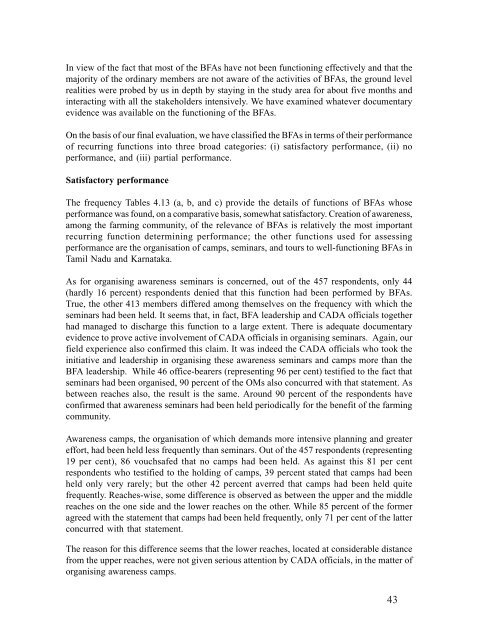Beneficiary Participation in Irrigation Water Management: The Kerala
Beneficiary Participation in Irrigation Water Management: The Kerala
Beneficiary Participation in Irrigation Water Management: The Kerala
Create successful ePaper yourself
Turn your PDF publications into a flip-book with our unique Google optimized e-Paper software.
In view of the fact that most of the BFAs have not been function<strong>in</strong>g effectively and that the<br />
majority of the ord<strong>in</strong>ary members are not aware of the activities of BFAs, the ground level<br />
realities were probed by us <strong>in</strong> depth by stay<strong>in</strong>g <strong>in</strong> the study area for about five months and<br />
<strong>in</strong>teract<strong>in</strong>g with all the stakeholders <strong>in</strong>tensively. We have exam<strong>in</strong>ed whatever documentary<br />
evidence was available on the function<strong>in</strong>g of the BFAs.<br />
On the basis of our f<strong>in</strong>al evaluation, we have classified the BFAs <strong>in</strong> terms of their performance<br />
of recurr<strong>in</strong>g functions <strong>in</strong>to three broad categories: (i) satisfactory performance, (ii) no<br />
performance, and (iii) partial performance.<br />
Satisfactory performance<br />
<strong>The</strong> frequency Tables 4.13 (a, b, and c) provide the details of functions of BFAs whose<br />
performance was found, on a comparative basis, somewhat satisfactory. Creation of awareness,<br />
among the farm<strong>in</strong>g community, of the relevance of BFAs is relatively the most important<br />
recurr<strong>in</strong>g function determ<strong>in</strong><strong>in</strong>g performance; the other functions used for assess<strong>in</strong>g<br />
performance are the organisation of camps, sem<strong>in</strong>ars, and tours to well-function<strong>in</strong>g BFAs <strong>in</strong><br />
Tamil Nadu and Karnataka.<br />
As for organis<strong>in</strong>g awareness sem<strong>in</strong>ars is concerned, out of the 457 respondents, only 44<br />
(hardly 16 percent) respondents denied that this function had been performed by BFAs.<br />
True, the other 413 members differed among themselves on the frequency with which the<br />
sem<strong>in</strong>ars had been held. It seems that, <strong>in</strong> fact, BFA leadership and CADA officials together<br />
had managed to discharge this function to a large extent. <strong>The</strong>re is adequate documentary<br />
evidence to prove active <strong>in</strong>volvement of CADA officials <strong>in</strong> organis<strong>in</strong>g sem<strong>in</strong>ars. Aga<strong>in</strong>, our<br />
field experience also confirmed this claim. It was <strong>in</strong>deed the CADA officials who took the<br />
<strong>in</strong>itiative and leadership <strong>in</strong> organis<strong>in</strong>g these awareness sem<strong>in</strong>ars and camps more than the<br />
BFA leadership. While 46 office-bearers (represent<strong>in</strong>g 96 per cent) testified to the fact that<br />
sem<strong>in</strong>ars had been organised, 90 percent of the OMs also concurred with that statement. As<br />
between reaches also, the result is the same. Around 90 percent of the respondents have<br />
confirmed that awareness sem<strong>in</strong>ars had been held periodically for the benefit of the farm<strong>in</strong>g<br />
community.<br />
Awareness camps, the organisation of which demands more <strong>in</strong>tensive plann<strong>in</strong>g and greater<br />
effort, had been held less frequently than sem<strong>in</strong>ars. Out of the 457 respondents (represent<strong>in</strong>g<br />
19 per cent), 86 vouchsafed that no camps had been held. As aga<strong>in</strong>st this 81 per cent<br />
respondents who testified to the hold<strong>in</strong>g of camps, 39 percent stated that camps had been<br />
held only very rarely; but the other 42 percent averred that camps had been held quite<br />
frequently. Reaches-wise, some difference is observed as between the upper and the middle<br />
reaches on the one side and the lower reaches on the other. While 85 percent of the former<br />
agreed with the statement that camps had been held frequently, only 71 per cent of the latter<br />
concurred with that statement.<br />
<strong>The</strong> reason for this difference seems that the lower reaches, located at considerable distance<br />
from the upper reaches, were not given serious attention by CADA officials, <strong>in</strong> the matter of<br />
organis<strong>in</strong>g awareness camps.<br />
43










